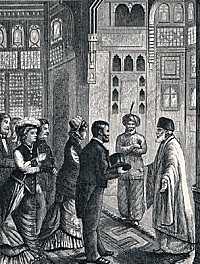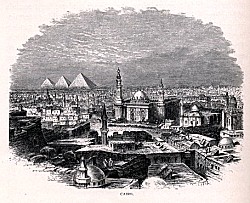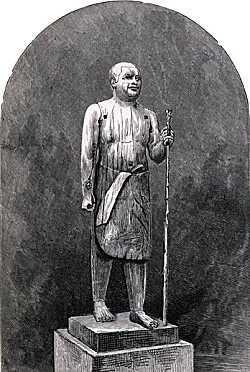|
 What
began as a small trickle of American travelers to Egypt in
the early part of the nineteenth century became a steady stream,
rivaling the flow of the Nile, by the first years of the twentieth
century. What
began as a small trickle of American travelers to Egypt in
the early part of the nineteenth century became a steady stream,
rivaling the flow of the Nile, by the first years of the twentieth
century.
By
the late 1860s, Thomas Cook and Son began offering Nile excursions
on steamers and luxurious dhahabîyehs, reducing
much of the hardship of earlier travel. These conveniences
brought more American visitors to Egypt, ranging from noted
public figures to midwestern businessmen and their families.
Soon, the exotic locales of Nubia and the oases of the Western
Sahara Desert were offered as de rigueur stops on the Grand
Tour for American travellers.
In
1867, Samuel Langhorne Clemens in the guise of Mark Twain
made a tour of Europe, Egypt, and the Holy Land and described
them in his book Innocents Abroad (1869). Americans
who later traveled through these same regions liked to retell
Twain's witty anecdotes and observations which they compared
to their own experiences.
A
number of the other Americans who published books based on
their own journeys to Egypt included Lincoln's Secretary of
State William H. Seward and his daughter Olivia (1871); essayist
and poet Ralph Waldo Emerson (1872-1873); industrialist Andrew
Carnegie (1879); journalist Richard Harding Davis (1892);
illustrator Charles Dana Gibson (1897-1898); and writer Henry
Adams (1898).
 Among
the other American visitors to Egypt at this time, but with
a much different purpose, were hundreds of Civil War veterans
who joined the army of the Khedive Ismail, serving in his
Ethiopian wars. Among those who wrote accounts of their adventures
were William Wing Loring, Charles Chaillé-Long, and
William Dye. Among
the other American visitors to Egypt at this time, but with
a much different purpose, were hundreds of Civil War veterans
who joined the army of the Khedive Ismail, serving in his
Ethiopian wars. Among those who wrote accounts of their adventures
were William Wing Loring, Charles Chaillé-Long, and
William Dye.
As
the century progressed, travel became easier and the reviewer's
prediction became a reality. Thus, in 1895 we find Agnes Repplier's
(1855-1950) account of "Christmas Shopping in Assuân"
in Atlantic Monthly where she notes, "shopping
on the Nile is a very different matter from shopping on Chestnut
Street or Broadway" (p.681).
By
1908, travel accounts were no longer tales of adventure and
hardship, but the tongue-in-cheek travails described by Lillian
C. Gilpin in "To the Pyramids with a Baby Carriage"
appearing in Harper's Weekly:
The
wheels of the baby's "Desert Schooner" cling
sorrily, so we halt, rig up a sort of awning over the
little one's head by means of a cotton sheet brought for
the purpose, and a couple of maize sticks pulled at the
foot of the great monuments to Time (p.30).
For
some, more bored than awed, this new traveler's Egypt had
lost the sense of wonder earlier travellers found. Travelers
such as the woman quoted in Constance Fenimore Woolson's (1840-1894)
"Cairo in 1890":
I
have spent nine long days on this boat, staring from morning
till night. One cannot stare at a river forever, even
if it is the Nile! Give me a thimble (p.665).
Though
perhaps lacking in the scope and grandeur of European accounts,
the American experience in Egypt has left an important and
fascinating record in a wealth of travel accounts.
 As
Woolson later noted, the American experience is still in its
infancy compared to the European nations: As
Woolson later noted, the American experience is still in its
infancy compared to the European nations:
In connection with the pyramids, the English may be said
to have devoted themselves principally to measurements.
The genius of the French, which is ever that of expression,
has invented the one great sentence about them. So far,
the Americans have done nothing by which to distinguish
themselves; but their time will come, perhaps. One fancies
that Edison will have something to do with it (pp.670-71)
In
retrospect, we can now see it was not Edison, but rather the
collected volumes of travel accounts with which Americans
made their mark. |



